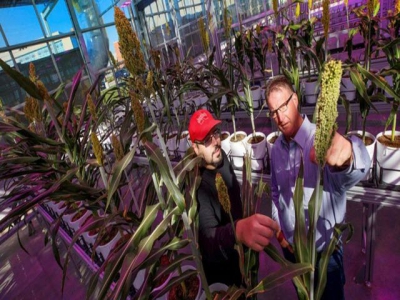Researchers aim to reduce nitrogen fertilizer use

Looking at sorghum, project to use high-tech phenotyping tools to improve nitrogen use efficiency.
James Schnable (left) examines a sorghum plant with Andy Benson in the Greenhouse Innovation Center. Schnable is part of a $3.9 million project that aims to develop crops that more efficiently use fertilizer.
While synthetic nitrogen fertilizer has been held up as one of the most significant agricultural breakthroughs of the 20th century, today’s agricultural researchers are turning to plant genomics to find solutions for growing crops more sustainably with fewer inputs, such as synthetic nitrogen fertilizer.
A University of Nebraska-Lincoln (UNL) research team and collaborators at the Alabama-based HudsonAlpha Institute for Biotechnology envision a solution that would reduce nitrogen fertilizer use without sacrificing yield or profit: plants bred with the ability to use nitrogen more efficiently than today’s crops. In the Corn Belt, for example, crops are unable to use 40% of the fertilizer applied to them, the university said in its announcement.
The researchers are advancing this work with a $3.9 million grant from the National Science Foundation. UNL's share of the award is about $1.3 million.
Although nitrogen fertilizer is an important tool for large-scale food production, it’s not without downsides -- from the natural resources used to manufacture the fertilizer to the cost to producers’ bottom lines and the environmental impacts resulting from overuse, which include reduced water quality and aquatic dead zones that threaten marine life, UNL said.
“Plants with better nitrogen efficiency would mitigate some of the problems of excessive fertilizer because we could reduce the amount of nitrogen required to get the same yield,” agronomy and horticulture assistant professor James Schnable said. “It would help farmers be proactive in reducing their fertilizer use, whether to save money or to cope with environmental regulations that may come about.”
To produce this heightened efficiency, the team is combining genomics, biotechnology and automated phenotyping in a three-phase research plan focused on sorghum, UNL said. The cereal crop is considered vital to solving food insecurity because it’s relatively water and nitrogen efficient and thrives in varied climates.
First, the HudsonAlpha group will comb through crop data to identify sorghum’s key gene networks involved in nitrogen use, identifying them as targets for change. UNL agronomist Tom Clemente will then use cutting-edge genome editing technology to add genetic variations that govern these networks, producing new varieties to pass on to Schnable and UNL researchers Yufeng Ge, assistant professor of biological systems engineering, and Jinliang Yang, assistant professor of agronomy and horticulture. That group will work together to use automated phenotyping to analyze the new sorghum breeds’ traits.
Then, the cycle begins again, as Schnable will return findings to the HudsonAlpha team, which can further hone in on the gene networks at play.
“The project is innovative because we’re closing the loop,” Schnable said. “It’s key to have this integration where you can make predictions, make edits and, after you see what happens, go back and make new and better predictions.”
Schnable’s work, called high-throughput phenotyping, capitalizes on the university’s state-of-the-art LemnaTec High-Throughput Plant Phenotyping System, located at the Nebraska Innovation Campus’ Greenhouse Innovation Center. The system revolutionizes the process of capturing a plant’s physical and biochemical properties, known as phenotyping, through a robotics-based process that moves conveyor belts of plants through several 360-degree imaging chambers.
These powerful cameras will produce high-resolution images of the modified sorghum plants across their 12- to 18-week life cycle, UNL explained. Software will then analyze their biomass and nitrogen abundance, providing clues about whether the genome edits succeeded in boosting nitrogen efficiency.
Phenotyping itself is not a new practice, Schnable said. It’s the ability to monitor the same plant periodically across its lifetime without physically destroying it to take measurements that makes the high-throughput approach so valuable. The UNL facility is particularly well suited to study sorghum, which often grows 5.0-6.5 ft. tall; the university’s phenotyping system can measure plants up to 8 ft. tall.
UNL said Clemente is contributing expertise in a technology equally revolutionary through CRISPR/Cas9, a gene editing technique that enables scientists to add novel variation to the genetics of plant cells. For the past three years, his laboratory has been using this tool in plants like tomatoes, soybeans, maize, wheat and sorghum, making genetic changes designed to impart beneficial traits that can be integrated into breeding programs.
For this project, Clemente’s team will introduce variations to genes that are key players in nitrogen use.
“These transdisciplinary-type research settings create a synergistic environment that significantly increases the likelihood of a strong return on investment from the funding,” said Clemente, the Eugene W. Price distinguished professor of biotechnology.
Có thể bạn quan tâm
 VietGAP and VietGAP oriented tea output reaches over 2,100 tonnes in Yen The district
VietGAP and VietGAP oriented tea output reaches over 2,100 tonnes in Yen The district 230 hectares of tea under VietGAP and VietGAP oriented methods mostly in Xuan Luong and Canh Nau communes this year.
 To find sustainable directions for agricultural products
To find sustainable directions for agricultural products Conference to connect the supply and demand of agricultural and fruit products in Binh Duong province in 2018. The conference aimed to promote agricultural
 Solutions for stable consumption of agricultural products
Solutions for stable consumption of agricultural products Over the past time, the expansion of connections to consume agricultural products is a problem that Binh Duong has paid special attention to.